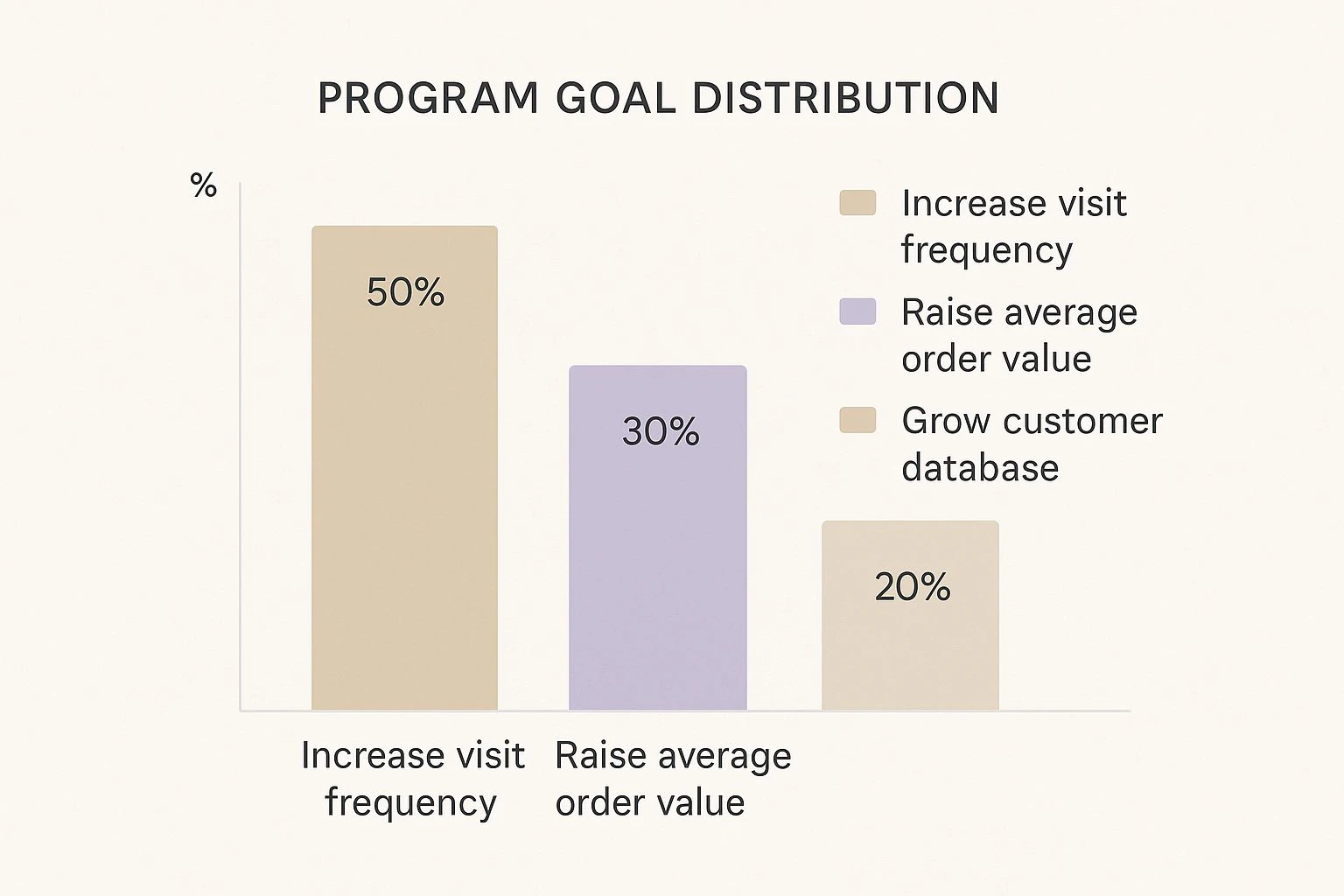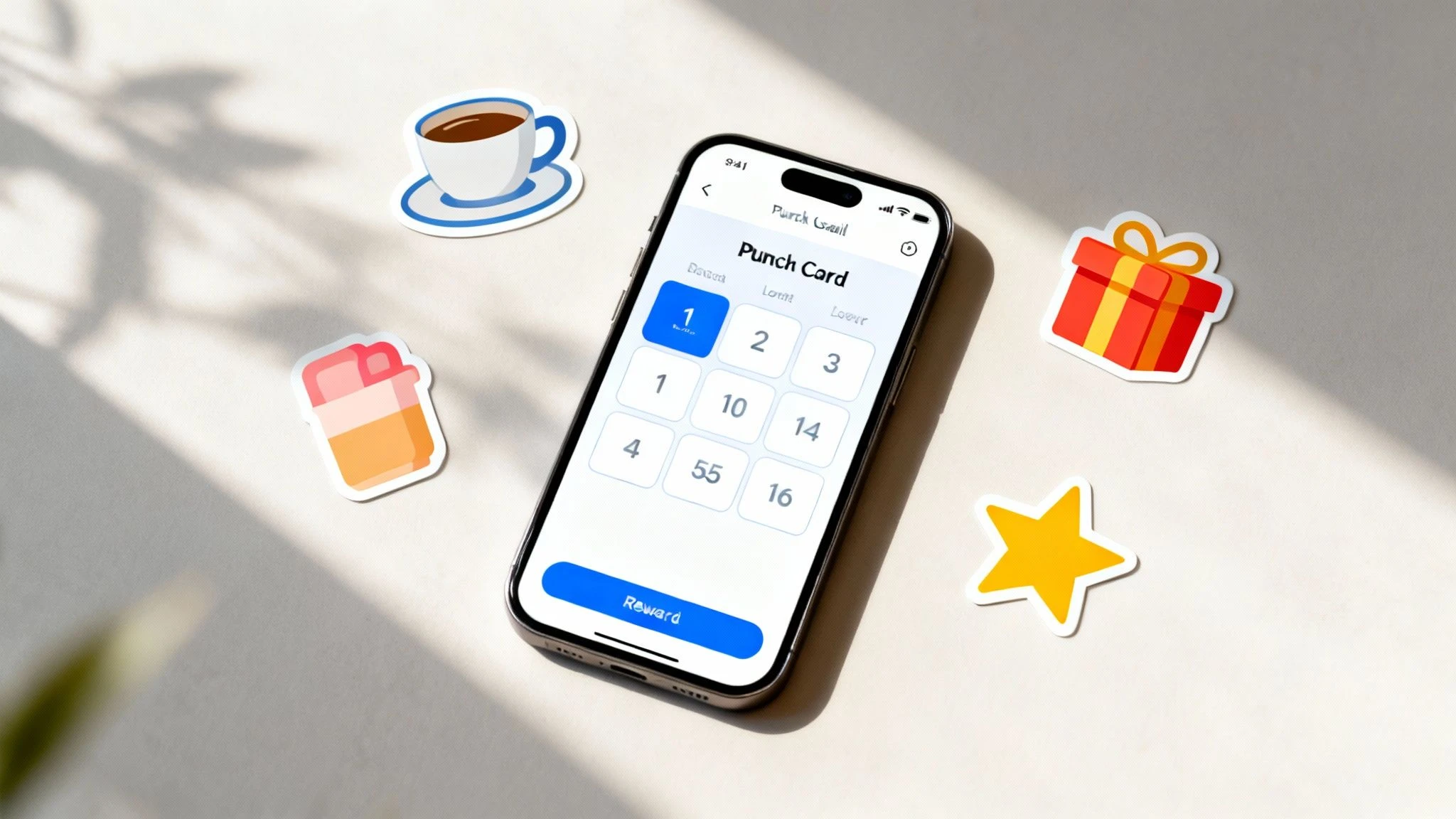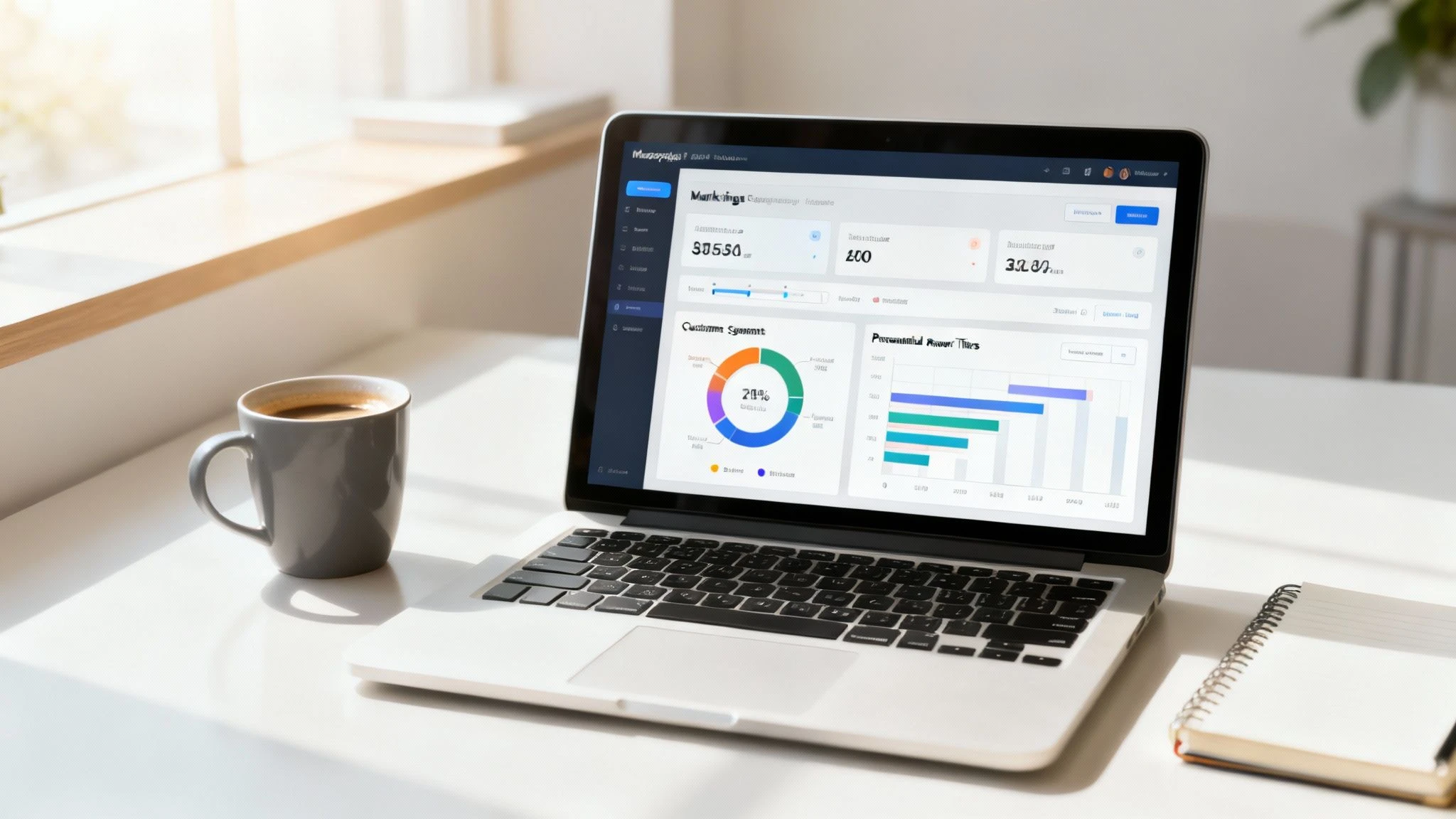So, you're thinking about setting up a rewards program. It's more than just picking a model and handing out discounts. A truly great system is simple enough for customers to get right away but valuable enough to actually bring them back through your doors.
Why Your Business Needs a Smarter Rewards Program
Let’s get one thing straight: a loyalty program isn't just some "nice-to-have" add-on. It's a powerful engine for real, sustainable growth. A well-designed program has a direct impact on your bottom line by turning casual shoppers into genuine fans of your brand.
Think about your local coffee shop. Without a program, a customer might swing by once a week. But with a simple digital punch card from BonusQR, that same person is now motivated to visit more often to earn that free coffee. You've just boosted their purchase frequency and, over time, their total value to your business.
Boosting Revenue and Customer Lifetime Value
Honestly, a smart rewards program is one of the best strategies for how to increase customer lifetime value and drive long-term growth. It’s not about giving away free stuff; it’s about building a two-way street. You reward customers for sticking with you, and in return, they give you more of their business.
This cycle is what helps you cut down on customer churn and build a much more stable revenue stream. If you want to dig deeper into the fundamentals, our guide on what a loyalty program is is a great place to start.
This approach transforms your customer base into a community that feels genuinely appreciated. And when people feel valued, they're far more likely to choose you over a competitor, even if it means spending a little more.
A loyalty program isn't an expense; it's an investment in your most valuable asset-your existing customers. It systematically encourages behaviors that lead to higher spending, more frequent visits, and powerful word-of-mouth marketing.
The Data-Backed Impact of Loyalty
The shift towards loyalty isn't just a hunch; it's a proven business strategy backed by hard numbers.
By 2025, it's expected that over 90% of companies will have some kind of rewards program in place. Why? The results speak for themselves. Around 58% of businesses see more repeat purchases, and nearly 70% report better customer engagement overall.
It's no surprise that some brands now dedicate up to 27% of their marketing budgets to loyalty and CRM. The data confirms it: a rewards program isn't just a tactic, it’s a core part of a winning strategy.
Building the Foundation for Your Loyalty Program
Before you even think about points or perks, let's talk strategy. Jumping straight into designing rewards without a clear plan is like building a house without a blueprint-it might look okay for a little while, but it's not going to last. A solid rewards program is built on three things: clear goals, a real understanding of your customers, and a budget that makes sense.
This initial planning is what separates the programs that fizzle out from those that become a core part of a business. So, start by asking yourself one critical question: what do I actually want this program to achieve? Vague answers like "more loyalty" won't cut it. You need specific, measurable goals.
Define Your Program's Primary Goal
Every business is different, and your loyalty program should be built to solve your specific challenges. Most program goals fall into one of a few key categories. Are you trying to get your regulars to pop in more often? Or is your main focus to get them to spend a little more each time they do? Maybe you're just looking to build a customer list you can reach out to with promotions.
Here’s a quick look at what most small businesses are aiming for.

As you can see, half of all businesses are focused on getting customers back through the door more frequently. It makes sense-building habits is a powerful way to lock in long-term revenue.
Picking one primary goal will steer every other decision you make, from the rewards you offer to how customers earn them. For a deeper look at getting the structure right, check out the 6 golden rules for setting up a successful loyalty program with points.
Understand Your Customers and Choose Rewards Wisely
Once your goal is set, it's time to get inside your customers' heads. A generic 10% discount might seem easy, but let's be honest, it's rarely exciting. The best rewards are the ones your audience finds genuinely valuable.
A coffee shop’s regulars might go crazy for a free pastry, while clients at a high-end salon would probably prefer an exclusive add-on service. Don't guess. Look at your sales data. What are your bestsellers? What do your most loyal customers buy over and over again?
A reward that feels personal and desirable is far more powerful than a generic discount. The goal is to offer something that makes your customer feel seen and appreciated, turning a simple transaction into a memorable experience.
Set a Realistic and Sustainable Budget
Alright, let's talk money. Your program's budget really comes down to three things you need to plan for:
- Software Costs: Modern tools like BonusQR have made the tech side incredibly accessible, with affordable monthly plans built just for small businesses.
- Cost of Rewards: This is simply the value of what you're giving away. A good rule of thumb is to keep this cost between 1-5% of a member's total spending.
- Marketing and Promotion: Don't forget to set aside a little something for the launch. We're not talking a Super Bowl ad here-just simple things like in-store flyers, a few social media posts, or some table tents to get the word out and drive those first sign-ups.
Nailing down your budget from the start ensures your program is financially sustainable. With these foundational pieces in place, you're ready to build a rewards program that your customers will actually love and, more importantly, one that delivers real results for your business.
Designing a Program That Customers Will Actually Use

Okay, you've got your goals locked in. Now comes the fun part: building a rewards program that actually gets people excited to participate.
The structure you choose is the backbone of your entire system. The trick is to find a model that fits your business like a glove, making it dead simple for customers to understand and genuinely rewarding for them to use.
Think about it. A local coffee shop thrives on frequent, small purchases. A simple digital punch card is perfect-it's visual, straightforward, and offers a quick payoff. We've actually dived deep into the psychology behind how cafe rewards programs work if you're curious. On the flip side, a high-end online boutique might get more mileage from a tiered system that encourages bigger spending to unlock exclusive perks.
Choosing the Right Program Model
The model you pick will directly shape how your customers behave. To help you decide, I've broken down the most common reward structures, outlining what they're good for and where they really shine.
Comparing Rewards Program Models for Small Businesses
Choosing the right structure is one of the most important decisions you'll make. This table breaks down the most popular models to help you find the perfect fit for your business and your customers.
| Program Type | Best For | Pros | Cons |
|---|---|---|---|
| Points-Based Programs | Businesses with a wide variety of products/services and purchase frequencies. | Highly flexible and easy for customers to understand. Encourages repeat purchases. | Can feel generic if not personalized. May take a while for customers to earn a meaningful reward. |
| Tiered Systems | Brands wanting to reward high-value customers and encourage increased spending. | Creates a sense of exclusivity and achievement (gamification). Drives higher customer lifetime value. | Can be complex to manage. May alienate customers who can't reach higher tiers. |
| Digital Punch Cards | Businesses focused on increasing visit frequency, like cafes, car washes, or salons. | Extremely simple and visual. Provides a quick, satisfying reward. Perfect for mobile. | Less effective for businesses with infrequent, high-value purchases. Limited data collection potential. |
| Cashback Programs | E-commerce stores and businesses where customers value immediate, tangible rewards. | Very straightforward and appealing. Customers see the value instantly, which drives conversions. | Can impact profit margins more directly. Doesn't build as much emotional connection as other models. |
Ultimately, the best program is one your customers will actually use. The right choice depends entirely on your business model, from the price of your products to how often people stop by.
Remember, the best rewards program is one that feels effortless for the customer. If they have to pull out a calculator to figure out its value, you’ve already lost their interest. Simplicity is your greatest asset.
Crafting a Compelling Rewards Catalog
So, what are you actually giving away? Your rewards are the heart of the program, and a well-designed catalog needs a smart mix of easily attainable perks and more aspirational, high-value prizes.
This balance is key to keeping people hooked. An easy win, like a free coffee or a product add-on, delivers that instant gratification that reinforces their decision to join in the first place.
Then you have the big-ticket items-a significant discount or an exclusive product-that give them a long-term goal to strive for. To get this right, you need to understand modern customer engagement best practices.
The data shows this stuff works. Research reveals that over 60% of loyalty programs successfully boost shopper loyalty. Better yet, 59% of members make at least one purchase a year through their program.
When the rewards hit the mark, customers don't just sign up-they stick around.
Bringing Your Rewards Program to Life
Alright, you’ve hammered out the goals and designed some killer rewards. Now for the fun part: making it all real. A brilliant idea is only as good as its execution, and for a small business owner, that means finding the right tools-ones that are powerful but don't require a computer science degree to operate.
Gone are the days of needing clunky software or hiring expensive developers. Modern platforms are built for people who wear a dozen hats a day. They handle the technical grunt work, so you can focus on what you do best: running your business and connecting with your customers.
Choosing the Right Tools and Tech
The secret is picking a platform that makes everything feel simple, from creating a digital loyalty card to weaving it into your daily workflow. You need a system that feels like a natural part of your business, not just another chore on your to-do list.
Take a platform like BonusQR, for instance. You can get a complete digital punch card or a points-based system up and running in minutes. Customers hop on board with a quick scan of a QR code, which completely gets rid of the hassle of paper cards or clunky sign-up forms.
That seamless experience is everything. Research shows 85% of consumers are more likely to stick with a brand that has a loyalty program, but that only works if joining is dead simple.
Look for a platform that gives you:
- Simple Digital Card Creation: The power to design a branded card that lives right on your customer's phone.
- Effortless Onboarding: A quick QR code scan should be all it takes for someone to sign up. No friction.
- Flexible Operation: The ability to either run it from a tablet or phone or integrate it directly with your POS system.
Here's a peek at the BonusQR dashboard. It’s designed to be clean and intuitive, putting everything you need right at your fingertips.
Issuing points, redeeming rewards-it’s all straightforward. No digging through complicated menus.
Crafting Your Launch Playbook
How you launch your program sets the entire tone. A big, enthusiastic rollout gets people excited and drives a wave of initial sign-ups. Don't just quietly turn it on one Tuesday morning; make an event out of it.
A multi-channel approach always works best. Start with your existing customers. They're your biggest fans and will be your first evangelists. Shoot a dedicated email to your list, announcing the new program and highlighting the perks of joining right now.
Next, hit your social media channels. Create a few simple, eye-catching posts that break down how the program works. A short, punchy video showing how easy it is to scan the QR code and join can do wonders.
Finally, bring the launch into your physical space. This is where the magic happens.
- In-Store Signage: Place flyers and table tents right at your checkout counter. Make the QR code impossible to miss and add a clear call to action like, "Scan to Join & Get Your First Reward Today!"
- Empower Your Team: Your staff is your most powerful marketing tool. Get them excited about the program. Give them a simple script they feel comfortable with, something like, "Are you part of our new rewards program? You get a free coffee just for signing up!" This one small step can skyrocket participation.
By marrying the right digital tools with a smart launch strategy, you'll bring your rewards program to life and start building stronger customer connections from day one.
Keeping Your Program Fresh and Engaging

So, you’ve launched your rewards program. That’s a huge win, but don’t pop the champagne just yet. The real work is just getting started.
A loyalty program isn't a crockpot you can "set and forget." It’s a living, breathing part of your marketing that needs regular check-ins to stay effective. That initial buzz will eventually quiet down, and you need a plan to keep customers hooked for the long haul.
The goal is to stop your program from feeling stale. This means going beyond basic points and discounts to create experiences that feel personal, exclusive, and genuinely exciting. When you continuously tweak and refine your approach, you turn a simple rewards system into a powerful retention machine that keeps your best customers coming back again and again.
Make It Personal
Generic rewards are forgettable. Personalized offers? Those make customers feel seen. Use the data you’re already collecting-like purchase history and how often someone visits-to craft rewards that actually mean something to them.
For instance, if a regular at your cafe always orders an oat milk latte, surprise them with a reward for a free one. It’s a small gesture, but it shows you’re paying attention and is way more powerful than a generic 10% off coupon. The data backs this up, too. Members who cash in on personalized rewards can spend 4.3 times more annually than those using generic ones. You can dig into more customer loyalty trends on antavo.com.
Create Tiers and Exclusivity
One of the best ways to keep people engaged is to give them something to work toward. Tiered programs are brilliant for this. They create a clear path for customers to unlock better and better perks as their loyalty grows. This taps into some basic human psychology-we all love to level up and gain a little status.
A tiered system basically gamifies the loyalty experience. It gives your most dedicated customers a goal to strive for, motivating them to spend more to unlock exclusive benefits that aren't available to just anyone.
This isn't some niche strategy; it’s everywhere. A whopping 70% of brands use tiered benefits to encourage customers to climb that loyalty ladder. On top of that, about 72% of brands see real value in creating that feeling of exclusivity around their programs. It’s a core part of building a rewards program that fosters a true community.
Analyze, Adapt, and Win
The data from your program is a goldmine. Don't let it just sit there collecting digital dust. Get in the habit of regularly reviewing your analytics to see what’s working and what’s falling flat.
Start by asking a few simple questions:
- Which rewards get redeemed the most? This tells you what your customers really want.
- How long does it take an average member to earn a reward? If it’s taking forever, they might just give up.
- Are my members spending more than non-members? This is the ultimate test of your program's ROI.
Use what you learn to make small, smart improvements. Maybe you ditch an unpopular reward and swap it for something more desirable. Or maybe you run a "double points" weekend to bring back members who haven't stopped by in a while. This constant cycle of analyzing and adapting is what keeps your program fresh, relevant, and profitable over time.
Got Questions? We’ve Got Answers.
Jumping into a new rewards program is a big move, and it’s smart to have questions. You’re investing your time and money, and you want to see it pay off. To help clear things up, we've pulled together the most common questions we hear from small business owners just like you.
Think of this as your final checklist before you hit ‘go.’ We’ll give you straight, simple answers so you can sidestep the usual hurdles and build a program that really clicks with your customers.
How Much Should I Actually Budget for This?
When you map out your budget, you’re really looking at three things: the software, the rewards themselves, and getting the word out. The good news is that modern tools like BonusQR are built for small business owners, so you can get started with an affordable monthly plan that won’t drain your cash flow.
Next up is the cost of your rewards. A good rule of thumb is to keep this cost between 1-5% of a member's total spending. Let’s say you offer a $5 reward after a customer hits the $100 mark-that’s a 5% cost on that specific revenue. Easy.
Finally, set aside a small amount for marketing. This doesn't have to be complicated. Simple in-store flyers or a small social media ad campaign to announce the launch is often all you need to get things moving.
What are the Big Mistakes I Should Avoid?
Even with the best plan, it’s easy to stumble. Knowing the common pitfalls ahead of time is your best defense.
Here are the mistakes we see most often:
- Making It Too Complicated: If your customers need a flowchart to understand how to earn and redeem, they’re out. Keep it simple. They need to get it in seconds.
- Offering Snooze-Worthy Rewards: A generic 10% off is forgettable. Dig a little deeper. What would your customers really get excited about? A free item they love? Early access? That's where the magic is.
- The "Set It and Forget It" Trap: A rewards program isn't a crockpot. It needs a little love and attention. You have to promote it regularly and check in on how it’s doing to keep the momentum going.
Honestly, the single biggest mistake is going silent after launch day. Your team is your #1 marketing asset. A simple reminder from them at checkout is the most powerful way to drive sign-ups.
How Do I Know If It’s Actually Working?
You don't need a PhD in data science to figure out if your program is a success. Just focus on a few key numbers that tell the real story of customer loyalty.
Start by tracking these three metrics:
- Customer Retention Rate: This is the big one. Are more people coming back after they join? If yes, it’s working.
- Purchase Frequency: Are your members shopping with you more often than non-members? This shows you're successfully changing their habits.
- Average Order Value (AOV): Are members spending more each time they visit? This is a direct line to your bottom line.
One more thing: keep an eye on your Redemption Rate. A healthy rate is generally over 20%. If people are actively cashing in their rewards, it’s a clear sign that you’ve created something they genuinely value.
Ready to build a rewards program your customers will actually use? With BonusQR, you can get a professional digital loyalty program up and running in minutes. Start building your program today!
